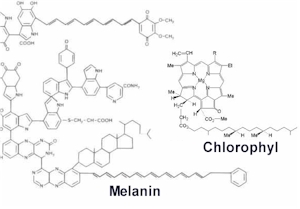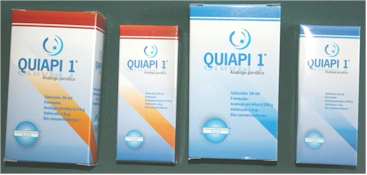Could Human Photosynthesis power the future?
Dr. Arturo Solis Herrera has developed a technology that utilizes the properties of melanin – the animal analogue to chlorophyll. His melanin based (polihydroxyindol) photo-cell absorbs a broad spectrum of electromagnetic radiation, and converts it into electricity. He has also developed a pharmaceutical claimed to enhance human "photosynthesis" for increased health.
by Hank
Mills with
Sterling D. Allan
Pure Energy Systems News
|
|
Plants utilize the green pigment chlorophyll to absorb energy from
sunlight to breakdown carbon dioxide into sugars. This is well known,
and taught in probably every elementary school across the world. What is
not as well known, is that the dark colored pigment called melanin found
in the skin of humans and other mammals can absorb various types of
electromagnetic radiation. In fact, melanin appears capable of absorbing
a much broader spectrum of such radiation than chlorophyll. This was
proven when scientists noticed various fungi growing in radioactive
environments actually seemed to be thriving. Testing of these fungi
proved the melanin producing their dark color was absorbing gamma
radiation and converting it to energy. The article, "Ionizing
Radiation Changes the Electronic Properties of Melanin and Enhances the
Growth of Melanized Fungi" published by Ekaterina Dadachova reviews
this discovery.
Long before the above article was published, Mexican researcher Dr.
Auturo Solis Herrera (medical surgeon, ophthalmologist, and
pharmacologist) of the
Human Photosynthesis
Study Center was performing research on disorders of the human eye.
His team started discovering the importance of the pigment Melanin
(known by the chemical name polihydroxyindol) in regards to eye
conditions. For some reason, Melanin seemed to protect the tissues of
the eye, but his team could not completely understand why the protective
effect was taking place. After extracting and applying melanin
therapeutically to the eyes of patients, they saw results they claim
were impressive.
As time passed it was discovered that melanin was actually collecting
energy from electromagnetic radiation, and using it to split water atoms
into hydrogen, oxygen, and four additional electrons. This process can
also act in reverse. Such a reaction is not exothermic (releasing
energy) but endothermic (storing energy). Dr. Auturo Herrera claims that
the hydrogen atom is then sent to cells where it can be recombined with
oxygen to produce energy (human body version of a fuel cell). The cells
can then use this energy to supplement the sugars the body provides
them. In this process, melanin acts like a catalyst which promotes the
chemical reaction, but is not consumed by it.
 Dr. Herrera goes so far as to say that melanin is a "super chlorophyll"
due to its many advantages over regular chlorophyll. He goes on to say
that, "melanin is to the animal kingdom what chlorophyll is to the plant
kingdom." A few of these advantages are claimed to include "hundreds of
reaction centers" compared to the single reaction center in chlorophyll,
the ability to absorb energy from a far broader portion of the
electromagnetic spectrum, and capability to function for years outside
of human tissue. Chlorophyll is claimed to become totally inactive after
only twenty seconds.
Dr. Herrera goes so far as to say that melanin is a "super chlorophyll"
due to its many advantages over regular chlorophyll. He goes on to say
that, "melanin is to the animal kingdom what chlorophyll is to the plant
kingdom." A few of these advantages are claimed to include "hundreds of
reaction centers" compared to the single reaction center in chlorophyll,
the ability to absorb energy from a far broader portion of the
electromagnetic spectrum, and capability to function for years outside
of human tissue. Chlorophyll is claimed to become totally inactive after
only twenty seconds.
The Human Photosynthesis Study Center claims that one third of the
energy available to a human being is produced by melanin absorbing
electromagnetic radiation, and splitting water into hydrogen and oxygen
to produce energy. If this claim turns out to be valid, it could have
tremendous implications in our understanding of life processes, cellular
processes, human health, and disease. Dr. Herrera claims that increased
levels of hydrogen in the mitochondria (the energy producing organelles
inside of human cells) improves their function, and may lower the
production of free radicals. This could be very significant, because
over time free radical production produces DNA deletions in the
mitochondria that cannot be effectively repaired. Unlike nuclear DNA,
mitochondrial DNA is located in loops. Once these loops of DNA are
damaged the efficiency of the mitochondria is reduced, more free
radicals are produced, and a cascade of damage begins. Mitochondrial
damage is implicated in everything from Alzheimer, dementia,
cardiovascular disease, and many other disorders.
Dr. Patrick Flanagan (who has wirelessly transmitted 1 MW through a
mountain, among other amazing feats) is another researcher who is
studying the function of hydrogen in the mitochondria, and has products
available http://phisciences.com/ to augment that function. Last week he
presented his technology in China at the invitation of the president of
China (we plan to do a story about that soon), and was treated like a
superhero.
A Unique Pharmaceutical
To enhance the benefits of melanin, the Human Photosynthesis Study
Center has developed a pharmaceutical drug called, "QIAPI
1." The center claims this drug can increase human
photosynthesis and help treat many different diseases and disorders. It
is being sold on their website for the "sale price" of $75 dollars.
(Please be warned that the product may or may not be safe. As far as we
know it has not been approved by the FDA. We are not advising anyone to
purchase the product, but are simply providing information about its
existence. Anyone who is considering purchasing the product should
consult their doctor, and do their own research.)

The box that contains the drug has the Spanish words "Analogo pirrolico"
on it, which translates to "pyrrole analog" or "similar to pyrrole." A
quick search for the meaning of pyrrole resulted in the following
definition.
"Pyrrole: One of a class of organic heterocyclic compounds of five-membered diunsaturated ring structure composed of four carbon atoms and one nitrogen atom. The simplest member of the pyrrole family is pyrrole itself, a basic heterocyclic compound; colorless to pale yellow, toxic oil with pungent taste and similar to chloroform odor; insoluble in water; soluble in alcohol, ether, and dilute acids; boils at 129 - 131 C; polymerizes in light. Pyrrole ring system is involved in coloured products (green pigment, chlorophyll; red, hemoglobin; , blue, indigo) in nature. Pyrrolidine, the saturated tetrahydropyrrole, is part of the structures of amino acids (proline, hydroxyproline and hygrine). Pyrroline is a pyrrole in which one of the two solid bonds has been hydrogenated. Pyrrole and its derivatives are widely used as an intermediate in synthesis of pharmaceuticals, medicines, agrochemicals, dyes, photographic chemicals, perfumes and other organic compounds. They are also used as catalysts for polymerization process, corrosion inhibitors, preservatives, and as solvents for resins and terpenes. They are used in metallurgical processes. They are useful in the intensive study of transition-metal complex catalyst chemistry for uniform polymerization, luminescence chemistry and spectrophotometric analysis."
The Human Photosynthesis website gives the following description.
"QIAPI 1 is result of 20 years of continued research. Actually is our best seller product because it's effects over the body induce an extraordinary generalized improvement. The quality of life of the patient is modified in a positive manner markedly. Usually, a patient could begin the treatment with just two drops sublingually each three hours during day. Please don't drink alcohol, nor energetic drinks, neither iron supplements. They are two concentrations: QIAPI 1 with blue box (normal concentration) and QIAPI 1 with red box that is the double of concentration and is recommended for difficult cases."
A very informative abstract gives another description of the drug and how it could be used to treat disease.
O7 - OXIDATIVE STRESS-INDUCED BRAIN HYPOMETABOLISM UNDERLIES THE PATHOPHYSIOLOGY OF ALZHEIMER DISEASE AND OFFERS NEW AND SUCCESSFUL TARGETS FOR TREATMENT: ASTONISHING THERAPEUTICS EFFECTS FROM A COMBINATION OF A MELANIN PRECURSOR (QIAPI-1) AND SELECTIVE MITOCHONDRIAL ANTIOXIDANTS (ALCAR+LA): NEW SCENT ON THE TRAIL? G. ALIEV1,2,3, H.H. PALACIOS4, J. LESZEK4, M.E. OBRENOVICH5, V. BRAGIN2, A. SOLIS HERRERA6 (1. University of A tlanta, A tlanta Georgia, USA ; 2. Stress Relief Center, Brooklyn, NY , USA ; 3. Department of Biology, University of Texas at San Antonio, San Antonio, Texas, USA; 4. Department of Psychiatry, Wroclaw Medical University, Wroclaw, Poland; 5. Department of Pathology, School of Medicine, Case Western Reserve University, Cleveland, Ohio, USA ; 6. Centro de Estudios de la Fotosintesis Humana. S.C., Aguascalientes, 20000, Mexico)
Aim: It is widely accepted that a neuronal energy crisis, cerebral hypometabolism and vascular hypoperfusion are major and potentially treatable contributors to the loss of function in patients with Alzheimer disease (AD). In addition, recently we have found an unexpected capacity for melanin to dissociate water and aid in the production of energy in the process. We hypothesize that melanin can be used as a new and more effective therapeutic approach in the treatment of AD patients. The E4 isoform of apolipoprotein E (ApoE) is involved in cardiovascular and cerebrovascular disorders and is the most prevalent risk factor for late onset of sporadic AD. Moreover, ApoE4 transgenic (Tg+) mice are appropriate models for studying the pathogenesis and preclinical treatment of ApoE-related cognitive deficits associated with late onset and sporadic AD. The goal of our work is to potentially target melanin's dissociation properties for therapy of the disease by using a combination of a selective mitochondrial antioxidant plus a melanin analogue developed by Dr. Solis (QUIAPI-1) both in combination with our recently developed brain exercise program. Clinical data were compared to our animal study on ApoE4 mice who received selective mitochondrial antioxidants acetyl-L-Carnitine and R-α -Lipoic acid (ALCAR+LA). Methods: This study applies the brain hypometabolism paradigm to AD patients in order to analyze cognitive function in patients who receive ALCAR+LA, Omega-3-6-9 Fish, Flax, Borage oil as well as Coenzyme Q-10 and QUIAPI-1 , along with diet changes in combination with our recently developed brain activation program (a home-based protocol involving mild physical exercise and cognitive training). The average years post treatment. In addition, our animal study applies the vascular dementia paradigm to ApoE4 Tg+ mice in order to analyze the effects of the selective mitochondrial antioxidants ALCAR+LA on cerebral blood flow (CBF), neuropathology, brain and vessel ultrastructural abnormalities and behavior. Results: Our clinical results showed that patients who received a combination of mitochondrial antioxidants and QIAPI-1 exhibited the maximum cognitive improvement at the end of 24 months of treatment. The maximum cognitive improvement was seen with the combined treatment in MMSE, attention, memory, naming, construction, clock drawing, verbal fluency, and Ruff Frontal Fluency tests. By the end of 24 months of treatment, significant improvement was observed, especially in attention, construction and clock drawing, when patients received the combined treatment. In addition, this group also showed that in all categories there were no signs of a decrease and/or decline below the base line for the entire period of treatment. ApoE4 associated factors reduced the CBF gradually and created brain hypoperfusion when compared to the wild-type (WT). The differences in CBF were greatest as animals aged from 6 weeks to 12 months. Transmission electron microscopy (TEM) with colloidal gold immunocytochemistry and in situ hybridization using human and mouse DNA probes showed structural damage and mitochondrial DNA overproliferation and/or deletion in the young and aged microvessels endothelium of ApoE4 animals, extending to the cytoplasm of perivascular cells, perivascular nerve terminals, hippocampal neurons, and glial cells. Spatial and temporal memory tests showed a trend in improving cognitive function in ApoE4 Tg+ mice who were fed the selective mitochondrial antioxidants (ALCAR+LA).
Conclusions: Our conclusion is that the potential pharmacologic modulation of brain hypometabolism by using human photosynthesis compounds such as selective mitochondrial antioxidants and a melanin analogue, and/or precursor represents a completely new and more effective strategy to treat Alzheimer and/or other dementia types. Moreover, further expanding the examination of the ultrastructural degeneration caused by aging, especially under cardiovascular disease complications, is likely to contribute to our understanding of neurodegenerative etiology and will indicate a new avenue for the development of novel prophylactic and treatment strategies by offering selective mitochondrial antioxidants like ALCAR+LA and QIAPI 1 to the demented patients.
--
This drug seems very interesting, but relatively little information
about it can be found on their website. The exact composition of the
drug does not appear to be specified. Additionally, there is no
information as to what extent it enhances "human photosynthesis." Even
if it does enhance human photosynthesis significantly, there is no hard
evidence that such an increase would be beneficial. There could be
unknown side effects.
Electrical Power from Melanin
Dr. Herrera has also developed a technology that produces electrical
output using melanin's ability to absorb electromagnetic energy and
split water. His photo-cells utilize a solution of melanin in water and
a pair of electrodes. A voltage potential is sent from the solution to
the electrodes that can power LEDs. Recently, he was able to produce
600mV and 200mA from a photo-cell. The output was used to power a music
player. He believes that the output can be increased, and could
eventually power a vehicle that would never need to be re-fueled.
Think of a solar cell, but in this case, the electromagnetic spectrum is
much wider than just the visible spectrum, so the melanin-based cell
could harness radio waves, infrared (heat), and more, allowing it to
pull power from a much wider array of environmental free energy.
Herrera believes that the energy being produced by the Melanin is from a
broad portion of the electromagnetic spectrum. Everything from gamma
rays to infrared to light.
He has submitted a series of patent applications covering his
technology. The following is a partial list.
-
PHOTOELECTROCHEMICAL METHOD OF SEPARATING WATER INTO HYDROGEN AND
OXYGEN, USING MELANINS OR THE ANALOGUES, PRECURSORS OR DERIVATIVES
THEREOF AS THE CENTRAL ELECTROLYSING ELEMENT -
EFFECTS OF THE PHOTOELECTROLYSING PROPERTY OF MELANINES, ANALOGUES
THEREOF AND DERIVATIVES THEREOF ON CELL BIOLOGY, AND USE THEREOF FOR
VARIOUS PURPOSES - METHOD FOR THE SYNTHESIS OF SOLUBLE MELANIN FROM PRECURSOR AMINO ACIDS
- USE
OF MELANINS AND PRECURSORS, ANALOGUES AND DERIVATIVES THEREOF AS
COOLANTS OF INDUSTRIAL, AUTOMOTIVE AND DOMESTIC PROCESSES, WITH THE
SIMULTANEOUS GENERATION OF ELECTRICITY
The latest development is that he claims to have developed a device
that utilizes melanin to power an LED based light bulb for one hundred
years. This device is called the Bat-Gen. A search for the official
website of the Bat-Gen was unsuccessful.
If the human body does obtain energy via photo-synthesis then it is
something that needs to be further researched. The implications are
enormous. It also brings up many questions. For example..
Which frequencies of electromagnetic waves are optimally absorbed by
human melanin?
What is the most optimum spectrum of electromagnetic waves for humans to
expose themselves to?
Can drugs that increase human photosynthesis improve human health?
Hopefully, more scientists and medical doctors will investigate these
questions!
------
A good over-view of this topic can be found in the following
PDF.
# # #
This story is also posted at
BeforeItsNews.
www.pureenergysystems.com
PES Network, Inc.
Copyright © 2003 - 2011
